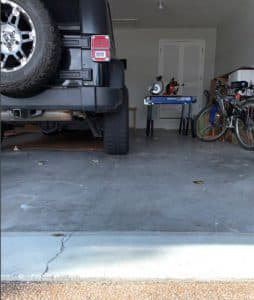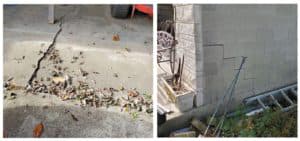
Garage floors take a lot of wear and tear from vehicles, heavy equipment, and seasonal temperature changes. Over time, these factors can lead to cracks, uneven surfaces, and other problems that affect both safety and appearance.
A garage is a major selling point for a home—and for good reason. Garages offer convenience and versatility, keeping your vehicle protected from the elements while also providing valuable storage space for tools and equipment. Whether you're changing the oil, tackling a messy DIY project like painting furniture, or even transforming your garage into an extra social space, maintaining a solid and stable floor is essential.
Because garages are such an asset to your home, regular upkeep is crucial. And like any other structure, they can experience issues related to a settling foundation. If you've been searching for floor repair near you, it's important to work with professionals who understand the complexities of garage floor and foundation repair.
Acculevel is a foundation repair company established in 1996, owned and operated by Andy Beery and his family. We’ve repaired tens of thousands of foundations and offer some of the best warranties in the industry. It can be tricky to diagnose the correct repair method for a garage floor, but we have the knowledge and experience to guide you through the process.
In this article, we’re going to explain the best methods for repairing a garage floor and foundation. We’ll clearly explain what to look for so you can determine what method you need, and provide additional resources that will help you calculate potential costs.
When a slab cracks down the center, it usually indicates that the ground under the slab has moved, creating a void under the floor. These voids are caused either by water eroding the dirt or by the soil settling.
Settling is a natural process; the pressure of the building’s weight forces the ground to compress. If your soil is granular (has sand or gravel pieces in it), it stacks more loosely and is more likely to have air pockets that allow for settling.
If erosion is your culprit, check to see where your gutters and downspouts are draining. We recommend downspouts to be extended at least 10 feet away from your home to reduce the risks of erosion and water damage. Need to extend your downspouts? We have a tutorial here.
 This photo was taken by an Acculevel project manager during a routine free estimate. The garage floor is cracked and sinking in the center
This photo was taken by an Acculevel project manager during a routine free estimate. The garage floor is cracked and sinking in the center
If your garage floor has a void underneath it, slabjacking is the best method for lifting the concrete back into position. Slabjacking means injecting a polyurethane foam through the concrete slab. As the fill is injected, it foams up and solidifies, raising the concrete as it does so. Once the slab is returned to its original position, the crack in the floor can be filled and sealed.
Here is a demonstration of the slabjacking process:
Want to learn more about slabjacking and its costs? This article explains how slabjacking compares to other repair methods, as well as providing cost estimates.
If the floor is sinking to one side, this could mean the garage foundation may be settling. This is usually indicated by cracking in the foundation and wall.
Before we can determine the best method(s) of repair, we need to assess the floor, and how it connects to the wall.
Does your garage floor stop at the wall, or does it extend all the way across? For example, in the pictures below, the concrete slab floor is also the base of the wall. This makes the floor part of the foundation.
 These photos were taken by an Acculevel project manager during a routine free estimate. The floor is cracked and sinking to the outside. The outside wall shows signs of settling.
These photos were taken by an Acculevel project manager during a routine free estimate. The floor is cracked and sinking to the outside. The outside wall shows signs of settling.
This means helical piers are the primary repair you need. A combined wall and floor allows piers to stabilize both the wall and the floor at the same time. In the picture on the right, you can see the outside of the garage has a classic stair-step crack; this indicates the front corner has settled and is pulling away from the rest of the wall. Piers will secure this corner and stop it from moving any farther away.
However, if the piers also lift the foundation, we recommend that you have slabjacking done as well. Not to lift the floor, but to fill the void created by the lift. (No lift = no void created = no slabjacking foam required.).
This article will give you an overview of pier installation and its associated costs.
On the other hand, if your garage floor stops at the wall and isn’t part of the foundation- then you have what is commonly referred to as a “floating slab” floor. If you’re wondering what is a floating slab foundation, it’s a type of concrete foundation that isn’t tied directly to the footing. In this instance, you will need both piers and slabjacking to repair your garage.
If so, then you need to find an experienced foundation repair company, and make an appointment. Before you sign a contract for any service, you should always verify the company is reputable, insured, and accredited by the Better Business Bureau. Haven’t hired a contractor before? Or not sure what you need to know? We have a guide to the questions you should ask a contractor, here.
If you live in Indiana or the surrounding states, contact Acculevel for a free estimate. An experienced project manager will evaluate your garage and recommend the best course of action for you.
[DISPLAY_ULTIMATE_SOCIAL_ICONS]